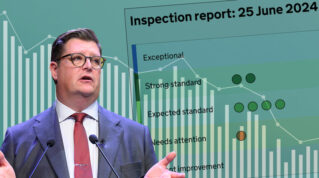Amanda Spielman steps down at the end of this month after seven years at Ofsted, leaving an education system with more schools rated ‘good’ or better.
But how much of the change during her tenure as chief inspector is due to genuine school improvement, and how much is down to changes to inspection?
FFT Education Datalab shared its latest analysis with Schools Week.
More schools ‘good’…
Datalab compared the grade profile of all schools in December 2016, just before Spielman took over, with the most recent grade profile in November 30 this year.
In 2016, 87 per cent of schools were judged ‘good’ or ‘outstanding’. Today that stands at 89 per cent.
The increase has been driven by a rise in the proportion of schools rated ‘good’ – from 67 to 73 per cent, and a corresponding drop in the proportion rated ‘requires improvement’ from 9.7 to 8.5 per cent, and ‘inadequate’ from 3.4 to 2.5 per cent.
…but fewer ‘outstanding’ grades
However, the proportion of schools rated ‘outstanding’ also fell, from 20 per cent seven years ago to 16 per cent today.
‘Outstanding’ schools were exempt from routine inspection for about a decade until a policy change in 2020. Many have since lost their top rating.
Ofsted’s framework also changed in 2019, focusing more on what is taught in schools than outcomes for pupils.
Most schools with a negative grade improve
The analysis also found that relatively few schools that were graded ‘requires improvement’ or ‘inadequate’ before Spielman took over remain so today.
Just 3 per cent of primary, 4 per cent of special and 9 per cent of secondary schools had judgments of less than ‘good’ at the beginning and end of the her appointment.
Do MATs boost Ofsted grade?
The number of schools in multi-academy trusts has ballooned during her tenure.
Datalab found the grades of schools in large trusts – those with 10 or more schools – have improved substantially.
In 2016, 66 per cent of schools in large MATs were judged ‘good’ or better, compared with 89 per cent of schools maintained by councils or in smaller trusts. As of November this year, 90 per cent of the same group of schools in large MATs had a positive Ofsted grade, the same as those in other structures.
But chief statistician Dave Thomson said “more needs to be done” to establish causality between MAT membership and improving Ofsted grades.
Poorer schools have improved…
Ofsted has often faced criticism that schools with more deprived intakes are less likely to get top grades.
Schools Week analysis found schools in the poorest areas are now getting better grades, but there is still a huge gap with their wealthier counterparts. Datalab’s analysis supports our findings.
‘Good’ or ‘outstanding ratings fell in schools with the lowest free school meals rate.
At primary level, the proportion of these schools with a top grade fell from 96 per cent in 2016 to 95 per cent this year. At secondary level, the fall was from 95 to 93 per cent.
Schools with the highest proportion of pupils eligible for free school meals tended to improve on reinspection.
At primary level, 80 per cent of schools in the top quintile were good or better in 2016, versus 86 per cent in 2023. At secondary level, the increase was from 57 to 74 per cent.
…but they’re more likely to have been inspected
Datalab pointed out that while “on the surface” this showed improved grades for disadvantaged schools, the most deprived schools were more likely to have had a full inspection since January 2016.
Of the least deprived, 40 per cent of primaries and 57 per cent of secondaries have been inspected since 2016, compared with 65 per cent of primaries and 83 per cent of secondaries in the most deprived quintile.
Hard to tell if schools are improving
Thomson said his analysis “raises the question of what it means to be ‘good’”. He pointed to the change in the early years of the coalition government when ‘satisfactory’ became ‘requires improvement’, which may have driven an increase in ‘good’ schools.
He also questioned how well the public understood the the differences in Ofsted framework and whether differences in framework could lead to different judgments about a school.
“This matters because claims are made about the quality of the schools’ system based on increasing percentages of schools judged ‘good’ or ‘outstanding’. But I’m not sure we have much idea from this data whether schools are improving or not.”















If the questions you raised can’t be answered after an OFSTED report, then it’s not actually fit for purpose.
What is the point at all of the process, if the gradings are not definitive?
Lynn’s point is correct, here. We know (now particularly) that the Ofsted process is a one-size-fits-all approach which checks compliance with the national criteria – dictated by the political agenda of the day. It is not good at considering local needs and it is not able to support the change needed to improve. It merely encourages (or forces) compliance at the expense of competence. Looking at this data in isolation of the real experience of pupils, teachers and the wider community, will make parental choice difficult and limit the long term value of government action that is based on this data.